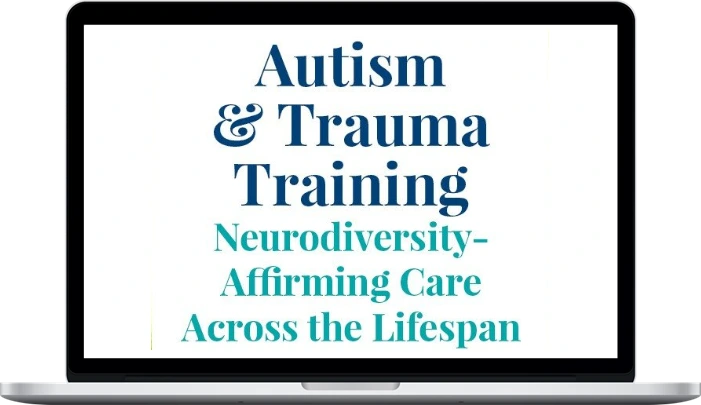PESI – Autism & Trauma Training for Neurodiversity-Affirming Care Across the Lifespan
$199.99 $100.00
»Delivery: Within 21 days
Description
PESI – Autism & Trauma Training for Neurodiversity-Affirming Care Across the Lifespan
Autism & Trauma Training for Neurodiversity-Affirming Care Across the Lifespan Comprehensive Tools for EMDR, ACT Mindfulness and More
Begin by enhancing your ability to conduct affirming and accurate assessments with your clients, particularly when it comes to the working with Autism and trauma together. Then progress into learning ACT, EMDR, TF-CBT, and Somatic strategies to alleviate trauma, support neurodivergence, and help your clients work toward their unique goals.
Module 1: Autism Assessment in Adults: Differentiating Co-Occurring Issues
Begin this training with autistic psychologist, speaker, and author, Dr. Wenn Lawson, who will teach you how to assess for autism and separate it from other co-occurring mental health issues in adults.
What You’ll Learn in Module 1
- Autism Assessment in Adults
- Teasing out autism from co-occurring mental health diagnosis
- Integrating a neurodiversity-affirming lens with DSM-5™ diagnostic criteria
- How autism presents differently in different gender identities
- The interplay between “poor” mental health and autism
- Reasons for a referral
Module 2: Autism and Childhood Trauma: ACT, CBT and EMDR Techniques
This part of the course will delve into the science behind resilience in developing brains, providing practical techniques to enhance communication, address sensory and physical obstacles, and boost cognitive functions. Additionally, you will receive advice on how to effectively work with young clients who may be resistant to therapy.
What You’ll Learn in Module 2
- Neuroscience and Resilience
- Signs of trauma in neurodivergent children
- Trauma-related behaviours vs disability-related behaviours
- Impact of neurodivergence on trauma processing
- Communication impairments
- Sensory processing disorder
- Physical disabilities
- Medical needs
- ASD-related behaviours
- Brain change through EMDR, ACT, CBT, and Somatic therapies
- Limitations of research and potential risks
- Navigate Communication Challenges
- Apps and tech to support 2-way communication
- Psychoeducation using social stories and video modelling
- Visual supports for emotion identification
- 5 art therapy techniques to communicate without words
- Defusion techniques for non-verbal children
- Case study: CBT for autistic teen engaging in self-harm
- Meet Sensory Needs
- Create a sensory-friendly space
- Quick & easy calming sensory strategies
- Sensory routines for emotional regulation
- In-session use of proprioceptive and vestibular strategies
- Interoception: its BIG role in emotions
- Left-right stimulation strategies
- Case study: Play therapy to address trauma in children with FAS
- Move Beyond Physical Limitations
- Modifications for play therapy techniques
- Positioning to support interaction
- Help kids set value-driven goals despite disability-related challenges
- Deal with disability-related identity issues
- Assistive technology in trauma work
- Case study: EMDR with child with CP and history of abuse
- Engage the Hard-to-Engage Child
- Movement before mindfulness
- Capitalise on routines and rituals
- Play-based trust-building strategies
- Puppets, sand trays, and dollhouses
- Case study: ACT with autistic child in foster care
- Support Cognitive Processing
- Strategies to build a sense of self
- Dramatic play for perspective-taking
- Resources for emotional identification and processing
- Visual supports for understanding and acceptance
- Building psychological flexibility through role-play
- Case study: CBT and child with Down syndrome
- Build the Child’s Dream Team
- Co-regulation strategies for caregivers
- Support attachment
- Routines-based intervention for the home
- Interdisciplinary collaboration for success
Module 3: EMDR, TF-CBT and Sensorimotor Therapy with Neurodivergent Kids and Teens
In this section, you’ll expand your toolbox by learning EMDR, Trauma-Focused cognitive, and sensorimotor techniques to help process trauma. Teaching from his personal experience with neurodivergence, this training with Sean Inderbitzen is full of insights to help overcome therapy-interfering behaviors, use a non-pathologizing polyvagal lens, guidance on creating visual aids for therapy, and keys to simplifying your language to meet clients where they’re at.
What You’ll Learn in Module 3
- Autism and Trauma: Overlap and Treatment Implications
- What is the window of tolerance and its relevance to Polyvagal theory?
- Rethinking autism: A Polyvagal Model of autism
- Implications of trauma on executive dysfunction and memory
- A case study of an autistic child with PTSD and dissociative amnesia
- The Diagnostic Intersection of Autism, OCD and PTSD
- Diagnostic criteria for ASD
- Diagnostic overshadowing in ASD, Obsessive Compulsive Disorder and PTSD
- Applying Polyvagal theory to the intersection of a state-specific model of autism
- Implications to diagnosis and treatment of autism and PTSD
- EMDR for Kids with ASD and PTSD: Adapting Social Stories and Tapping for Enhanced Treatment
- EMDR protocol walkthrough
- Visual aids for improved psychoeducation on trauma symptoms
- Adapting social stories to the treatment of trauma in children with ASD
- Using tapping for simple stress reduction
- Case study
- Research and limitations
- Sensorimotor Psychotherapy: Treat the Symptoms of Unresolved Trauma in the Body
- Mindful awareness of the body — helping kids with autism identify triggers
- Modified mindfulness exercises to activate calm in children with ASD and PTSD
- Simplified language to teach deep breathing and relaxation techniques
- Case study
- Research and limitations
- Trauma-Focused Cognitive Behavioural Therapy: Adaptations to Address Developmental Level and Increase Comprehension
- Modifications for using Trauma-Focused Cognitive Behavioural Therapy
- Strategies to increase generalisation
- Tips for overcoming concrete thinking
- Integrating visual learning to illustrate points
- Deepening TF-CBT practices with motivational interviewing
- Research and limitations
- Applying EMDR, TF-CBT, and Sensorimotor Psychotherapy to a state-specific model of ASD
- Modifications for using Trauma-Focused Cognitive Behavioural Therapy
Module 4: High-Functioning Autism and Trauma: Gentle EMDR Processing Techniques
In this workshop, renowned expert Dr. Sandra Paulsen shares an insider’s perspective, clinical experience, and research findings that will help you develop trauma processing skills from EMDR and other modalities. From a neurodivergent viewpoint, you will discover key considerations and learn strategies that enhance your therapy.
What You’ll Learn in Module 4
- Neurodiverse & Neurobeautiful
- A different nervous system
- Seeing gifts instead of pathology
- Discover your client’s superpowers
- Recognise high-functioning vs savant
- Utilise screens, assessments, and scales
- Autism and the Brain
- Seemingly contradictory qualities of “high functioning”
- Foundation of Pankseppian Affective Processing Theory
- Dendritic branching and associative linkages
- Developmental considerations and differences
- Impact of a lateralised brain
- Amygdala and the “deep brain”
- Additional challenges related to trauma processing
- The Phenomenology of High-Functioning Autism
- It all begins with Spoon Theory
- When the pot boils over… meltdowns, overload & shutdown
- The constant challenge of self-regulation
- Sensory protectiveness & stimming for self-regulation
- Understand “monotropism” & the problem of interruption
- Silence in the DSM: Somatic Features
- Masking and Adaptive Morphing
- The Eight Phases of EMDR & Other Trauma Processing
- The Common Trauma Loop
- Overcome the “chicken vs the egg”
- Core narratives from social rejection
- Steps to connect and build rapport sensitively
- Considerations & adaptations for the EMDR phase
- Overcome common challenges to using EMDR with HFA
- How to incorporate storytelling
- Diverse assessments and scales
- What to do when dissociation is present
- Being patient — allowing for silence with delayed processing
- Considerations for working with children
- Use body scans effectively and appropriately
- Closure and follow-up, how it’s different
Module 5: Motivational Interviewing Tools and Techniques for Adults with High-Functioning Autism
Join Sean Inderbitzen, a member of the Motivational Interviewing Network of Trainers, for a workshop with incredible insights on how MI can be used most effectively from the perspective of both a clinician and a person with autism. Gain tools to increase intrinsic motivation, improve emotion identification, and reduce resistance to change.
What You’ll Learn in Module 5
- Motivational Interviewing (MI) and ASD: What the Research Says
- Matching developmental freedom and personal autonomy: Activity
- Recommendations for balancing safety and autonomy
- Person-centred strategies and their impact on patients with ASD
- Feedback Informed Treatment (FIT) and MI
- MI Techniques for Improving Pragmatic Language
- Exercise on social pragmatics and depression (Thomas Gordon’s process)
- Case study: Social pragmatics and meaning-making
- Social pragmatics and its effect on self-esteem and motivation
- Help clients navigate ambiguity
- Decreasing “black” and “white” thinking patterns
- Increasing clients’ ability to identify reasons for change and build motivation
- Responding to change talk in HFA
- Hacks for social pragmatics
- MI Strategies for Treating Anxiety and Depression
- Recognise “black” and “white” thinking patterns
- Open-ended questions, Affirmations, Reflections and Summaries (OARS)
- Cultivate change talk for motivation: Case example
- OARS real play activity
- Flipping the righting reflex demonstration
- Evoking confidence for change in HFA: Exercise
- Menu of Options — using closed-ended questions
- MI risk and limitations in the ASD population
More courses from the same author: PESI
Delivery Policy
When will I receive my course?
You will receive a link to download your course immediately or within 1 to 21 days. It depends on the product you buy, so please read the short description of the product carefully before making a purchase.
How is my course delivered?
We share courses through Google Drive, so once your order is complete, you'll receive an invitation to view the course in your email.
To avoid any delay in delivery, please provide a Google mail and enter your email address correctly in the Checkout Page.
In case you submit a wrong email address, please contact us to resend the course to the correct email.
How do I check status of my order?
Please log in to HealthcareCourse account then go to Order Page. You will find all your orders includes number, date, status and total price.
If the status is Processing: Your course is being uploaded. Please be patient and wait for us to complete your order. If your order has multiple courses and one of them has not been updated with the download link, the status of the order is also Processing.
If the status is Completed: Your course is ready for immediate download. Click "VIEW" to view details and download the course.
Where can I find my course?
Once your order is complete, a link to download the course will automatically be sent to your email.
You can also get the download link by logging into your HealthcareCourse account then going to Downloads Page.
Related products
Total sold: 1
Total sold: 1










